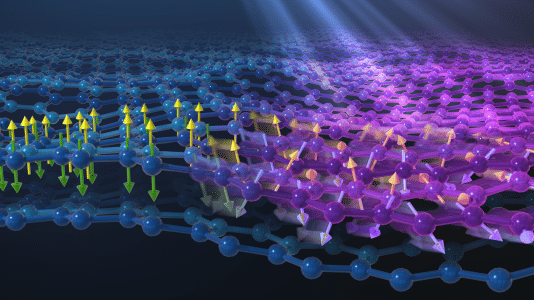Magnetic materials have long been the subject of research into how microscopic spin configuration results in unusual properties at the macroscopic length scale. One such example is the Einstein-de Haas effect in ferromagnets, which allows the angular momentum of spins to be transferred into the mechanical rotation of an entire item. However, it is still unclear how spin ordering couples to macroscopic movement in antiferromagnets without a net magnetic moment.
In a new study, a team of researchers from Argonne and other U.S. national laboratories and universities now report an analogous yet different effect in an “anti”-ferromagnet. In this experiment, researchers exploited electron spin to elicit a mechanical response in a cylinder, a macroscopic object.
In antiferromagnets, for instance, the electron spins alternate from up to down between adjacent electrons rather than always pointing up. Antiferromagnets do not react to changes in a magnetic field like ferromagnets because their opposing spins cancel each other out.
Haidan Wen, a physicist in the Materials Science and X-ray Science divisions of the U.S. Department of Energy’s (DOE) Argonne National Laboratory, said, “The question we asked ourselves is, can electron spin elicit a response in an antiferromagnet that is different but similar in spirit to that from the cylinder rotation in the Einstein-de Hass experiment?”

The researchers created a sample of the antiferromagnet iron phosphorus trisulfide (FePS3) to provide an answer to that query. Each layer of the sample, which was made up of several FePS3 layers, was only a few atoms thick. FePS3 is unique to a conventional magnet since it is created in a layered structure with very weak interaction between the layers.
Wen said, “We designed a set of corroborative experiments in which we shot ultrafast laser pulses at this layered material and measured the resultant changes in material properties with optical, X-ray, and electron pulses.”
The researchers discovered that the pulses alter the material’s magnetic properties by jumbling the ordered orientation of electron spins. Instead of alternating between up and down in a systematic way, the arrows for electron spin are now disorganized.
Nuh Gedik, professor of physics at the Massachusetts Institute of Technology (MIT), said, “This scrambling in electron spin leads to a mechanical response across the entire sample. Because the interaction between layers is weak, one layer of the sample can slide back and forth with respect to an adjacent layer.”
The oscillation time for this motion is extremely short—10 to 100 picoseconds. The definition of a picosecond is one trillionth of a second. Light only moves a third of a millimeter in one picosecond because of how quickly this happens.
World-class scientific facilities are needed to measure samples with atomic-scale spatial resolution and picosecond-scale temporal resolution. The scientists used state-of-the-art ultrafast probes that analyze atomic structures using electron and X-ray beams to achieve this.
The early experiments used the mega-electronvolt ultrafast electron diffraction equipment at SLAC National Accelerator Laboratory and were inspired by optical measurements at the University of Washington. At MIT’s ultrafast electron diffraction setup, additional research was done. Work at the 11-BM and 7-ID beamlines at the Advanced Photon Source (APS) and the ultrafast electron microscopy facility in the Center for Nanoscale Materials (CNM) added these findings. At Argonne, CNM and APS are DOE Office of Science user facilities.
A multilayer antiferromagnet also experiences effects from the electron spin at durations longer than picoseconds. The team members found that fluctuating motions of the layers significantly slowed down around the point when the electron spins switched from disordered to ordered behavior in an earlier work employing APS and CNM equipment.
Zong said, “The pivotal discovery in our current research was finding a link between electron spin and atomic motion that is special to the layered structure of this antiferromagnet. And because this link manifests at such short time and tiny length scales, we envision that the ability to control this motion by changing the magnetic field or applying a tiny strain will have important implications for nanoscale devices.”
Journal Reference:
- Zong, A., Zhang, Q., Zhou, F., et al. Spin-mediated shear oscillators in a van der Waals antiferromagnet. Nature (2023). DOI: 10.1038/s41586-023-06279-y
